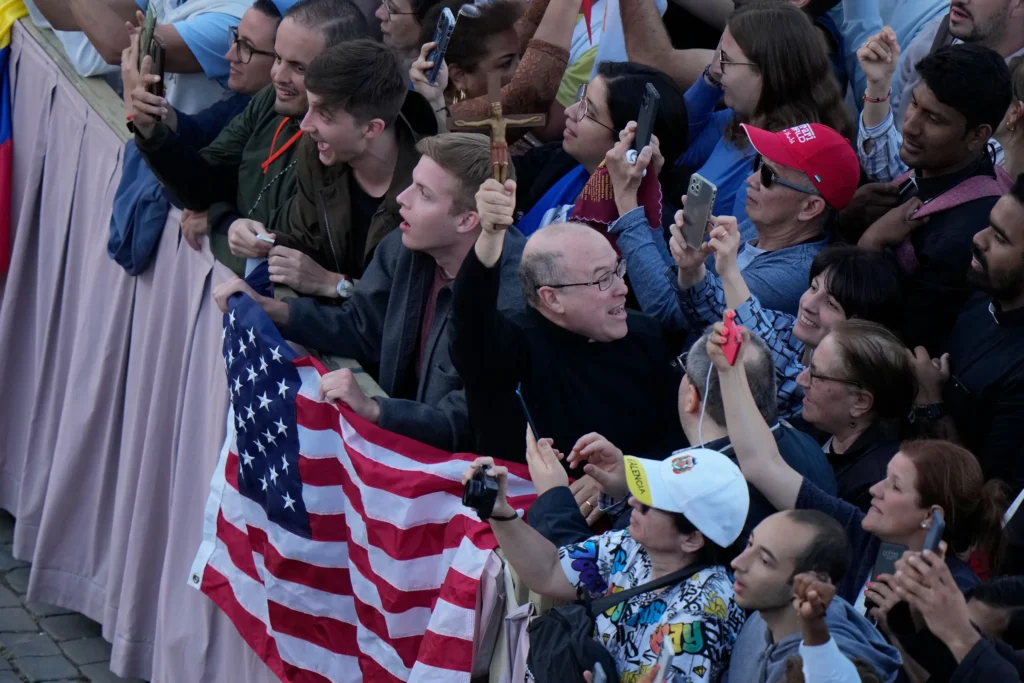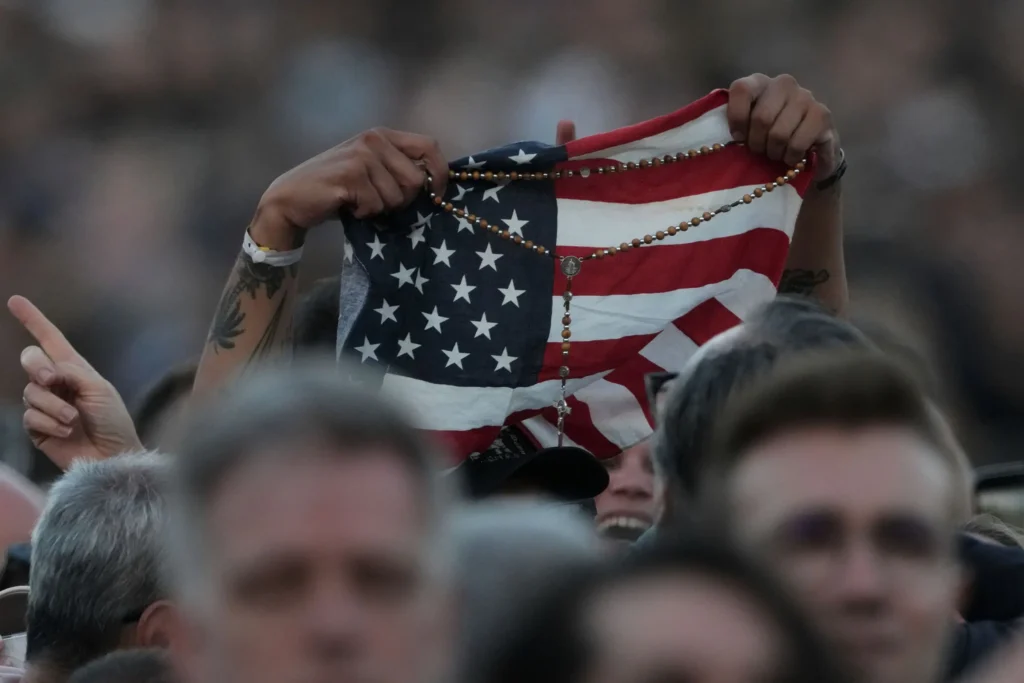Celebrity worship creates mirages. Media attention to the coronation of Robert Francis Prevost as Pope Leo XIV is not all that it seems. The 24-7 news feed degrades the new pope into a celebrity before he has begun to govern.
When white smoke went up the Vatican chimney, emotional display rose to fever pitch in St. Peter’s Square. The spectacle of uninhibited emotionalism evoked the sentimental spree that Britain reveled in after Princess Diana was killed in a car crash in Paris in 1997. Nearly three decades ago Britain dissolved in what the press called “Dianaweek.” [According to biographer Edward White, that week generated more media coverage than any other event in world history—including World War II.]
Throughout that week the news cycle binged on grief. For some weeks now our own media has binged on facile euphoria. An American pope! A Sox fan! A registered Republican! The Catholic commentariat is singularly elated. Against all odds, and in relief from the psychic strain of the Bergoglian pontificate, Leo’s enthronement is taken as a high-sign from Providence.
We need to step back from the mystification of a man few of us had heard of before May 8th. It is unwise to project desired meanings onto a fledgling pontificate. Wishful thinking is the victory of feelings over discernment.
While the Dianification of the papacy began before Francis, it reached a crescendo during his tenure. Among ongoing uses is its value as a Trojan Horse—a hollow trap for conservative Catholics in particular. Inside a structure strategically papered with invocations in Latin, there is much room for left-leaning social justice theory that functions as the contemporary proxy for the intentions of liberation theology.
Addressing the Conference of Latin American Bishops in Puebla, 1979, John Paul II cautioned against “manipulation by ideological systems and political parties.” His warning remains relevant as a brake on unchecked elation less suited to the papacy than to a World Cup winner or a Taylor Swift dazzle. Here is Rachel Wu in The Catholic Thing: “Everywhere he goes, he is thronged by joyful crowds. In America, too, Catholics are celebrating. We still can’t quite believe that we have an American pope.”
The gushing distracts from more considered responses, such as those quoted in The Times, London.
“This is a very significant choice, because it’s a vote against America since he has been a leading opponent of Donald Trump,” said Franca Giansoldati, a Vatican expert at Italy’s Il Messaggero newspaper.
Father Thomas Reece, a senior analyst at Religion News Service and an American himself, said: “This is a big surprise . . . . Much of the global south was suspicious of an American leading the Catholic Church, but the cardinals were fine with Prevost. Latin America’s cardinals appear to have united behind him. They saw him as someone representing the Americas, not just America. They saw him as one of their own, not as a gringo.”

Attentive to milestone events, the Empire State Building lit up in papal colors on May 8th. The light show glowed in white and yellow to toast what is called—imprecisely—the first American pope. As an early headline in The Catholic Thing effused “An American Pope At An American Moment.” That rote incantation obscures the critical point of the conclave’s embrace of Robert Prevost. Namely, that this also a Peruvian moment, one celebrated exuberantly across Latin America.
Leo XIV is a dual citizen: American by birth and Peruvian “by choice and conviction” in the words of Peru’s president, Dina Boluarte. She added: “The pope is Peruvian. God loves Peru.”
Under a 1980 pact between the Holy See and Peru, every bishop in Peru is legally obligated to be a Peruvian citizen. By law, bishops are accountable to Peru’s jurisprudence and policies. Robert Prevost took the exceptional step of assuming Peruvian citizenship in August, 2015, preliminary to appointment as Bishop of Chiclayo one month later. A Peruvian subject, he has pledged allegiance to the laws and—the frequently altered—Constitution of a politically unstable country.
Acquiring citizenship is more than a benevolent sign of affinity between a bishop and the society he serves. It implies enlistment in the state—a mandate to assure loyalty to the political and cultural context in which a bishop works. It also bears on the appointments he makes in office. In Leo’s case, the setting includes a Latin American nation with a tenuous capacity to govern itself.
There is no expiration date in the 1980 pact. It was signed by Pope John Paul II and then-President Fernando Belaúnde Terry, returned to power after ouster by military junta in 1968. At the time he represented a pro-American stance and opposition to military dictatorship. This is not the place to detail the chaotic history of modern Peru. What matters here is that 1980 was the hey day of both liberation theology, and the Peruvian terrorist group Shining Path. John Paul saw Belaúnde as a counter to both. But things change.
In the hierarchy of classification, Peru ranks as a “developing nation.”
To call it Third World is deemed passé. Nonetheless, its political volatility, high-profile corruption, and acute economic inequality remain. Modified remnants of Shining Path—such splinter groups as the Military Communist Party of Peru—still function in depressed regions. These played a part in Boluarte’s handling of power.
Americans exhibit placid indifference to Peruvian affairs. Yet it might be wise to seek a clear view of Bishop Prevost’s response to them as a citizen.
Did the bishop vote for or against Dina Boluarte, the “accidental president” with an approval rating of about three percent? Boluarte came to office in 2022 after having served as the V.P. of ousted president Pedro Castillo. The most recent in a rapid succession of presidents, he came into office in 2021; was deposed in 2022. Both Boluarte and Castillo took office as members of Free Peru (Perú Libre), the Marxist party heavily supported by lower earning and rural Peruvians.
Following caudillo custom, Boluarte used the Peruvian military to quell angry demonstrations by Castillo’s supporters protesting his ouster. The fury resulted in the Ayacucha and Juliaca massacres. The first occurred the day after Boluart’s inauguration; the second, in 2023. At the time, Prevost stated his”sadness and pain” at the deaths of some 49 protesters and bystanders in 2022. It was an ambiguous response. Sorrow is an emotion, not a judgment. Compare it to his unequivocal opposition to capital punishment: “It’s time to end the death penalty.“
Provost blamed the unrest on historic neglect of Peru’s poor, adding: “This conflict does not represent the best of the country.”
His statement avoided outright condemnation of the killings. [The military fired point blank into crowds. Investigation confirmed that people were “killed, without exception, by gunshot wounds.”] It also suspended judgment on the actions of the protesters. Instead, Prevost shifted blame to what any Marxist would recognize as a signal of class indifference: a structural circumstance that transcends individual responsibility. In other words, blame lay not with human beings but in the ordained conflict between the oppressed and the oppressors. As Gustavo Gutiérrez wrote: “Class struggle is an actual fact and neutrality on this subject is absolutely impossible.”
Prevost’s language left a door ajar for movements that base their hopes on what the father of liberation theology termed “social revolution”—meaning a radical restructuring built on “a will to build a socialist society.”
Ed Condon initially described Leo as Francis 1.5
That is not Francis 2.0, but close enough if viewed through the lens of American politics and geopolitical maneuvering.
Leo chanted the Regina Coeli in the classic Gregorian melody on May 11th. This heartened conservative Catholics who long for liturgical expression that resonates with the historical treasury of the ancient Latin Rite. These are the same Catholics most in accord with J.D. Vance and Tom Homan on repudiation of illegal migration and its corrosive effect on the social order—in particular, the welfare of the American working class.
It is fair to think a conclave packed with Francis’s appointees might dangle a liturgical carrot to conservative— particularly American—Catholics. An armistice in the liturgical wars would serve nicely as a stalking horse for left-leaning pieties repackaged as a sequel to Rerum novarum. We forget that liberation theology was a clerical movement, conceived and promoted by what Pascal Bruckner termed “Third World lovers” in religious and academic circles. Peruvian philosopher and Dominican priest Gustavo Gutiérrez published The Theology of Liberation in 1971. The religious left has had more than half a century to remodel the aims and rhetoric of Third-Worldism to conform to traditional appeals to Christian compassion.
Catholic orthodoxy is already conflated with appeals to the “dignity” of illegal aliens and the politics of the climate change gospel. Judging by his pre-election tweets as Cardinal Prevost, Leo’s pontificate promises continuity with his predecessor’s embrace of illegal migration, the gospel of climate change, and rejection of capital punishment, and with it of traditional just war theory.
There is a compelling question sheltering behind today’s battles over liturgy and the low-hanging fruit of LGBTQIA2S+ agenda. It is the same question James V. Schall, S.J., asked some thirty years ago: “Will political ideology, delivered in religious language, become the form Catholicism will continue to take in Latin America?”
And by extension, in what remains of the West?



